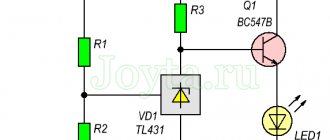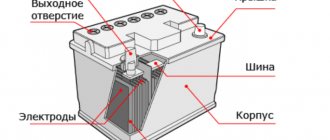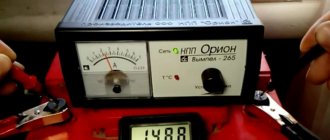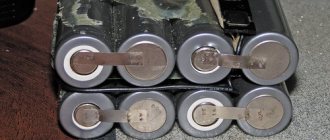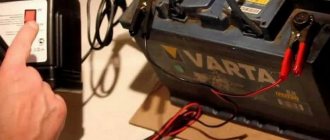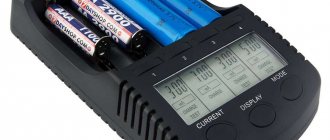Scientific and technological progress in all spheres of human activity increasingly requires backup sources of electrical energy. Modern batteries are difficult to maintain and limited in the amount of electrical charge. A supercapacitor (ionistor) is a powerful energy storage device that will replace traditional batteries in the future.
Supercapacitors
Concept
Large capacitors accumulate electrical charge due to a double electrical layer. An electrical double layer (EDL) allows the energy potential to be stored several orders of magnitude higher than that of a conventional capacitor.
DES is a layer between plates of ions that covers the surface of particles at the phase boundary. The charge of one layer of ions is compensated by the potential of the second layer of counterions. The thickness of the DES is negligible, while at the same time the area of the porous linings is huge.
The ionistor uses DES between carbon and electrolyte. The electrode is solid activated carbon, and the electrolyte is in liquid form. When these two media are in close contact, the positive and negative poles have a very narrow gap between them. When exposed to an electric field, a double electric layer is formed on the surface of the electrolyte adjacent to the coal.
Ionistor with double electrical layer
The use of a double electrical layer instead of a dielectric makes it possible to unlimitedly increase the electrode surface. As a result, a small supercapacitor can have a capacity of several farads at voltages from 2 to 10 volts.
Important! Improvement of the ionistor will lead to the fact that in most cases they will use a supercapacitor instead of a battery.
First test with engine start
I bought 6 supercapacitors and a balance protection board, sometimes they are sold individually for each ionistor, and sometimes there is a whole line for six pieces.
Put it all together.
The protection board prevents overcharging of supercapacitors with voltages above 2.7V, so it is almost mandatory to use it if the elements are connected in series.
Next, I soldered the terminals and installed this battery on the car. But first it must be charged with a small current of 5-7 A to operating voltage. This took 10-15 minutes.
After connecting, the car started up without unnecessary difficulties, the engine ran stably, and the voltage in the on-board network was kept at the proper level.
During this experiment, the following advantages and minutes were revealed: the battery of ionistors quickly discharged when the ignition was turned off, namely, after about 5-6 hours, the voltage dropped to 10 V. This was a minus, but the plus was that even at this voltage the car still started, since for the ionistor any voltage is working, unlike the battery.
As a result, it was no longer possible to start the engine after one day. And I decided to correct this shortcoming in the next design.
The history of the supercapacitor
Ionistor - what is it and where is it used?
In 1957, the American company General Electric patented a capacitor with a double electrical layer and porous carbon electrodes. The concept of the patent was that the accumulation of electrical potential occurred in the pores of carbon.
However, already in 1966, a company from Ohio, SOHIO, received a patent for an ionistor that accumulates charge in a double electrical layer. In 1971, NEC, which acquired the patent from SOHIO, began producing products called the Supercapacitor.
In 1978, Japanese radio manufacturer Panasonic flooded the market with supercapacitors called the Gold capacitor. In the same year, the first supercapacitors with a capacity from 0.1 to 50 farads were developed and manufactured in the USSR.
The most common cause of breakdown and traditional solution
Many car enthusiasts actively use photo and video recorders, equipping the car interior with them. But only a few drivers know that the device, like a mobile phone, runs on a battery, and if it breaks down, the device also breaks down and stops charging from the car’s electrical system.
Unfortunately, “original” batteries have a rather short life cycle, which leads to frequent breakdowns of the recorder itself. In this case, replacing the battery will eliminate the cause of the malfunction, bringing the device back to life.
Despite such an easy solution, car owners simply throw out “dead” equipment, replacing it with a new one.
Types of ionistors
Electric field energy
Supercapacitors are divided into three types:
- The “ideal” ionistor is a capacitor with ideally polarizable carbon electrodes. The charge occurs due to ion transfer from one electrode to another. A 30% solution of potassium hydroxide (KOH) or a 38% solution of sulfuric acid (H2SO4) is used as an electrolyte.
- Capacitors with weakly polarizable cathodes or anodes are hybrid ionistors. The electrochemical reaction occurs at only one of the electrodes.
- Pseudocapacitors are ionistors with electrodes on the surface of which reversible electrochemical processes occur. The products have a high specific capacity.
Comparison
What is a capacitor used for?
Supercapacitors (SC) are mainly used when it is necessary to store information in the memory of various devices and briefly support their power supply. Ionistors prevent data loss and reset of settings in mobile electronic devices when changing batteries (batteries, rechargeable batteries).
Note! Along with this, it is impossible to fully use a supercapacitor instead of a battery. If we compare the ionistor with the battery, we can note certain advantages and disadvantages of the SC.
Advantages
- Charging and discharging high current;
- Resistance to quality loss after 100 thousand charge-discharge cycles;
- Internal resistance prevents rapid self-discharge, overheating and destruction of the SC;
- After 50 thousand hours of operation, the ionistor loses a small part of its capacity;
- The ionistor has a small mass compared to similar electrolytic capacitors;
- Immunity to sudden changes in ambient temperature;
- Resistance to external mechanical influences.
Flaws
- High risk of destruction during a short circuit for SCs with large capacity and low internal resistance;
- Low operating voltage;
- High degree of self-discharge;
- Slow charge release;
- High price.
Scheme
Here is a diagram of the second battery prototype.
Let me make a reservation right away: it does not have a solar panel or a second battery. It also uses a line of supercapacitors with a balanced board. Also added is a battery charge controller, a pair of switches, a voltmeter and a small battery with a capacity of 7.5Ah. The operation of the device is as follows: before starting the car, open the hood and press the top switch according to the diagram. Through a powerful 50 Watt resistor with a resistance of 1 Ohm, the ionistor begins to charge from the battery. You cannot charge directly without this resistor, as this will be tantamount to a short circuit for the battery.
Everything takes 15 minutes. For me this is not critical. After this, you can start the car and drive. A Schottky diode is also connected in parallel to the resistor. It serves to charge the battery after the engine is started. And the battery is charged through the charging controller.
It is needed so that you don’t have to click the power switch every time, but turn it on once and go: stand at the store and leave for a couple of hours. And if the ionistor begins to draw current from the battery and discharge it below 11.4 V, the charging controller will immediately turn it off. This will protect the battery from being completely discharged, which could destroy it ahead of schedule. The switch at the bottom of the diagram is used to connect the voltmeter either to the ionistors or to the battery.
Practical application of supercapacitors
Modern ionistors have found wide application in such areas as:
- Vehicles;
- Consumer electronics.
Vehicles
Supercapacitors have recently begun to be built into vehicles powered by electricity.
Heavy and public transport
Not long ago, electric buses jointly produced by the South Korean company Hyundai Motor and the Belarusian enterprise Belkommunmash hit the streets of Minsk. The new public transport is equipped with an electric motor powered by energy from on-board ionistors. Muscovites were pleased with the domestically produced electric buses that entered city routes in May 2019.
City transport using ionistors is capable of traveling a route to the final stop with recharging at 2 or 3 stops. Charging time takes 2-3 minutes, which is quite enough for disembarking and embarking passengers. The capacitor power system is fully charged at the end stations within 8-10 minutes.
Cars
The world's leading car manufacturers are constantly improving their electric vehicles. At international exhibitions, special attention is paid to machines powered by supercapacitors.
Automotive supercapacitor
Recently, Russian manufacturers presented the Yo-mobile, which uses supercapacitors as the main source of electricity.
Additional Information. In vehicles running on liquid fuel, ionistors are increasingly being used for easy engine starting at low temperatures.
SK for engine starting
Auto racing
Automotive companies that produce electric vehicles and their hybrid modifications regularly hold auto races with cars using supercapacitors. This is done to advertise and promote their products in the global car market.
Consumer electronics
No complex electronic device can do without supercapacitors. They can be found in backup power for laptops, smartphones and other household appliances. Ionistors are needed where it is necessary to maintain power supply during an interruption of communication with the main current source.
Uninterruptible power supplies (UPS) are built on ionistors. UPS are indispensable where power supply depends on intermittent power sources, such as wind generators, solar panels, etc.
Ionistor for UPS
Home craftsman's advice
At first glance, it seems that replacing the battery built into the DVR with a similar one is very simple. But in most cases, the search for a similar battery takes a long time, and buying one takes a significant toll on your pocket.
To save resources, you can purchase a battery for phones and recharge a “dead” device from it. As practice shows, a video recording device works perfectly on external batteries with a capacity of 1200-2000 mA*s.
They will maintain “life” in the device much longer than its built-in power supply, and their relative cheapness is a pleasant advantage.
An unexpectedly “dead” recorder is a problem that can be solved using a conventional external power supply from a mobile phone. This way out of the situation will save money and time, which can be spent searching for a “native” battery.
(
8
votes, average:
3,63
out of 5)
Loading…
Development prospects
Mass production of hybrid public transport is expected in the near future. These are trolleybuses that will be able to cover sections of roads without trolls using power from on-board ionistors. They will be able to maneuver in places where the booms would be an insurmountable obstacle to traffic.
Scientists around the world are searching for new materials to create especially powerful supercapacitors. Such ionistors could completely replace traditional batteries.
DIY ionistor
To make a supercapacitor at home you will need:
- foil from a pack of cigarettes (dielectric);
- activated carbon tablets (electrode);
- water-soluble acrylic varnish or PVA glue (electrolyte).
You can make a homemade ionistor as follows:
- Cut out 2 rectangles from foil.
- Coal tablets are ground in a mortar to a fine powder. This can also be done in a coffee grinder.
- Charcoal powder is mixed with acrylic varnish.
- The resulting mixture is applied with a brush to one of the pieces of foil.
- After drying, a second layer of carbon is applied, then the process is repeated.
- Using PVA glue, glue the second rectangle of foil. The supercapacitor is ready.
- By connecting the wires to two opposite sides of the product, you can charge the ionistor using any battery.
DIY supercapacitor
Scientific and technological progress in creating perfect sources of electricity does not stop for a second. In the near future, high-quality high-voltage supercapacitors will be created, which will make a technological revolution in almost all areas of human activity.

